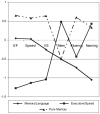Heterogeneity in mild cognitive impairment: differences in neuropsychological profile and associated white matter lesion pathology
- PMID: 19891820
- PMCID: PMC3034688
- DOI: 10.1017/S1355617709990257
Heterogeneity in mild cognitive impairment: differences in neuropsychological profile and associated white matter lesion pathology
Abstract
This study examined whether distinct neuropsychological profiles could be delineated in a sample with Mild Cognitive Impairment (MCI) and whether white matter lesion (WML) burden contributed to MCI group differences. A heterogeneous, clinical sample of 70 older adults diagnosed with MCI was assessed using cognitive scores, and WML was quantified using a semi-automated, volumetric approach on T2-weighted fluid-attenuated inversion recovery (FLAIR) images. Using cluster and discriminant analyses, three distinct groups (Memory/Language, Executive/Processing Speed, and Pure Memory) were empirically derived based on cognitive scores. Results also showed a dose dependent relationship of WML burden to MCI subgroup, with the Executive/Processing Speed subgroup demonstrating significantly higher levels of WML pathology when compared to the other subgroups. In addition, there was a dissociation of lesion type by the two most impaired subgroups (Memory/Language and Executive/Processing Speed) such that the Memory/Language subgroup showed higher periventricular lesion (PVL) and lower deep white matter lesion (DWML) volumes, whereas the Executive/Processing Speed demonstrated higher DWML and lower PVL volumes. Results demonstrate that distinct MCI subgroups can be empirically derived and reliably differentiated from a heterogeneous MCI sample, and that these profiles differ according to WML burden. Overall, findings suggest different underlying pathologies within MCI and contribute to our understanding of MCI subtypes.
Figures




References
-
- Bombois S, Debette S, Delbeuck X, Bruandet A, Lepoittevin S, Delmaire C, et al. Prevalence of subcortical vascular lesions and association with executive function in mild cognitive impairment subtypes. Stroke. 2007;38(90):2595–2597. - PubMed
-
- Bondi M, Monsch A, Galasko D, Butters N, Salmon D, Delis D. Preclinical cognitive markers of dementia of the Alzheimer type. Neuropsychology. 1994;8:374–384.
-
- Bondi MW, Salmon DP, Galasko D, Thomas RG, Thal LJ. Neuropsychological function and apolipoprotein E genotype in the preclinical detection of Alzheimer’s disease. Psychology and Aging. 1999;14(2):295–303. - PubMed
-
- Bowler JV. The concept of vascular cognitive impairment. Journal of the Neurological Sciences. 2002;203–204:11–15. - PubMed
-
- Bowler JV, Hachinski V. Vascular cognitive impairment: Preventable dementia. Oxford University Press; NewYork: 2003. Vascular cognitive impairment – A new concept.
MeSH terms
Grants and funding
LinkOut - more resources
Full Text Sources

